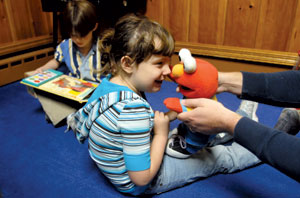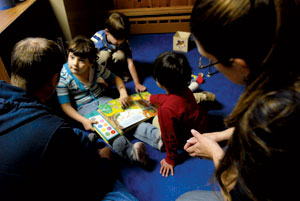Like most 5-year-olds, Ian tests his boundaries, waiting for his teacher to be distracted to coyly make a move for the door. He’s bright, observant and expressive. But Ian, who is diagnosed with a form of autism, is hyper and doesn’t yet communicate with words. Prone to outbursts and sometimes biting his hands or other objects, he requires constant one-on-one attention in the classroom.
Special education teachers throughout the Flathead Valley and Montana are developing new programs to serve the increasing number of students who, like Ian, have autism. Still, at the same time they’re seeing growing need, special education programs are grappling with stagnant state funding – forcing administrators to reach deeper into local school district coffers.
 |
|
Ian, left, follows the hand motions of Michael Weidemen durig the song Itsy Bitsy Spider. The hand gestures help associate the words of the song with physical actions. |
Number of Autistic Students Grows
Once viewed as a rare disorder, the diagnosis of autism is becoming increasingly prevalent in the general population.
Nationally, there are more than 500,000 children diagnosed with some degree of autism, and that number keeps growing. In recent estimates, one in every 150 children is believed to have some form of the disorder. Groups advocating more research money call autism “the fastest-growing developmental disability in the United States.”
The cause of the increase in autism is widely debated. Most scientists believe the illness is influenced strongly by genetics, while some citizens put childhood vaccines at fault. Nearly all school officials, national and local, agree that improved diagnosis, heightened awareness and the fact that the definition of autism has been evolving and expanding has played a role.
In Montana, statistics from the state’s Office of Public Instruction show the number of autistic students has swelled from 212 in the 2001-2002 school year to 442 last year – a 108.5 percent increase in just seven years. The number of autistic students jumped 9 percent between 2006 and 2007 alone.
“Our increase follows the national trend; it’s our fastest growing need,” OPI Superintendent Linda McCulloch said. “I’ve requested funding this year for five autism specialists – one specialist for each mental health region in the state – to assist with needs for the schools.”
In the Flathead Valley school officials say the total percentage of special needs students in their districts is remaining relatively steady – about 10 to 12 percent of the total school population. But the severity and certain types of needs, like autism, are rapidly increasing.
Local Districts Prepare to Meet Autistic Needs
Autism encompasses a wide spectrum of behaviors and learning problems: Some children with autism are completely nonverbal, while on the other end of the spectrum, children with milder forms, such as Asperger’s syndrome, may be very talkative. The variety of symptoms makes it particularly challenging for schools to help these kids learn and is requiring new programs locally to meet their needs.
Ian and two other 5-year-olds are students at the Communication Center in Kalispell. In a small classroom at the United Methodist Church, Missy Ueland teaches Ian basic skills through constant repetition. For six hours each school day, the children at the center receive one-on-one instruction in an effort to get them to where they could – at least partially – join a traditional kindergarten class.
 |
|
Kailee sings the song “Head, Shoulders, Knees and Toes” with help from Elmo, being held by Michael Weideman, while Conner reads a book during playtime at the Communications Center. |
In its first year, the center was started to help the area’s special education cooperative’s growing number of preschool-aged special needs and autistic students. The cooperative pools resources to serve all the rural school districts in Flathead County and two each in Lake and Lincoln counties.
“In the last three years, the demand for services for autism and Asperger’s has increased greatly as well as the need for services for preschoolers,” Noranne Yeager, the cooperative’s director, said. “The first year I was here there were maybe about four preschoolers identified for special education; now, we’re close to 15 or 20.”
In Columbia Falls, the district tapped speech language pathologist Ginny Shayne to head up its new communication program, which will focus on the social, emotional, behavioral and communicative needs of autistic students, beginning this year.
And at the Kalispell School District a group of parents of students with autism wrote a grant last summer and received $25,000 to start a pilot program this year at Edgerton Elementary School. The program focuses on autistic students whose primary education still comes from the regular classroom, and aims to improve integration by offering more training and teaching materials for general education teachers.
“They have students with ASD (autism spectrum disorder) in our district and just wanted to strengthen the options, and knowing money is tight they went after outside funds,” Chris Bilant, federal projects director for the district, said.
As State Funding Lags, Local Districts Foot Bill
Beyond developing new programs, one of the biggest challenges for special education is funding. For example, schooling for one student at the Communication Center costs about $30,000 per year.
When the state mandated education for all students, no matter their disability, in the early 1970s, the state government paid all costs associated with special education, McCulloch said. But funding soon shifted to a mixture of state, federal and local school district monies and the state’s share of that portion – with the exception of an increase in the late 1980s – has steadily declined, or at best, remained stagnant.
From 1990 to 2007, a time of increased costs and flat state funding, the state share of total costs for special education slipped from about 81.5 percent to about 36 percent. It’s fallen to local school districts to make up the difference.
 |
|
Students Kailee, Conner and Ian, center left to right, share a Winnie the Poo book and are encouraged to recognize colors and sounds from teachers Michael Weidemen, left, and Missy Ueland during a class at the Communications Center. |
“For over a decade there’s been virtually no increase in state funding for special education, which means that more and more had to be redirected to special education from a school district’s local monies,” McCulloch said.
In Columbia Falls, Superintendent Mike Nicosia said the school district will shift $900,000 this year from its general budget, monies used for everything from building maintenance to textbooks, to special education.
Last week, Nicosia, who is also the co-chairman of the Montana Quality Education Coalition, and other education groups renewed their lawsuit against the state, arguing the state has failed to come up with an adequate school funding formula.
In 2004, the Montana Supreme Court ruled that school funding was inadequate, and the Legislature held a special session the next year to increase school funding. But MQEC said the increase wasn’t enough and renewed the lawsuit.
Nicosia says adequate state funding for special education is key to the overall solution.
“They were aware, as we were aware, that the needs for those special education kids were increasing,” he said. “The state has just chosen not to live up to its responsibility to fund those programs.”
“If they were even to return to 80 percent of special education funding that would free up millions and millions of dollars in the general funds to buy textbooks, supplies, technology – any of those things that have been shortchanged over the years,” Nicosia added.
In addition to her budget request for autism specialists, McCulloch is also asking for an approximately $18 million increase in state special education funding over the next two years.
On the local level, special education teachers and administrators pride themselves in finding “creative” solutions to funding constraints. In the face of growing needs, special education, they say, is more important than ever.
“I think schools are absolutely amazing for what they’ve put in place,” Ueland, Ian’s teacher, said. “We’re the one agency or institution that doesn’t walk away, no matter what budget shortfalls there are.”